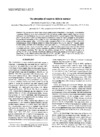Identificador persistente para citar o vincular este elemento:
https://accedacris.ulpgc.es/jspui/handle/10553/1165
| Campo DC | Valor | idioma |
|---|---|---|
| dc.contributor.author | Millero, Frank J. | es |
| dc.contributor.author | González-Dávila, Melchor | es |
| dc.contributor.other | Facultad de Ciencias del Mar | es |
| dc.contributor.other | Departamento de Química | es |
| dc.date.accessioned | 2009-10-08T02:31:00Z | - |
| dc.date.accessioned | 2018-03-01T13:48:13Z | - |
| dc.date.available | 2018-03-01T13:48:13Z | - |
| dc.date.issued | 1990 | es |
| dc.identifier.issn | 0016-7037 | es |
| dc.identifier.other | Hosting | es |
| dc.identifier.uri | https://accedacris.ulpgc.es/handle/10553/1165 | - |
| dc.description.abstract | The interaction of metal ions with particulate matter is important in limiting their concentration in seawater. Chitin is one of the constituents of the natural particulate organic matter than can interact with metal ions and therefore may serve as a reasonable model for natural organic solids. The adsorption of Cu2+ on the chitin surface has been studied in seawater as a function of pH, temperature, and salinity. The amphoteric properties of the surface of chitin were characterized in 0.7 M NaCl in terms of a two-protic acid-base system (pHPZC = 5.4) with acidity constants and . The maximum proton exchange capacity of chitin was found to be 2.3 ± 0.3 mol kg−1, broadly similar to other solids. The rates of the adsorption were quite rapid () and not strongly affected by the presence of other metals such as Cd2+ and Pb2+. The adsorption equilibrium data have been found to correlate well with surface complex-formation equilibria or the mathematically equivalent Langmuir- type adsorption equilibria. The value for the stability constant of Cu2+ on chitin was found to be , and the complexing capacity of chitin was found to be 6.9 and 5.9 μmol g−1, respectively, in the absence and in the presence of Cd2+ and Pb2+. An increase in the salinity and a decrease in the temperature result in greater adsorption of Cu2+ to chitin | en |
| dc.language | spa | es |
| dc.relation.ispartof | Geochimica et Cosmochimica Acta | es |
| dc.source | Geochimica et Cosmochimica Acta [ISSN 0016-7037], v. 54, p. 761-768 | es |
| dc.subject.other | Quitina | es |
| dc.subject.other | Cobre | es |
| dc.subject.other | Adsorción | es |
| dc.title | The adsorption of copper to chitin in seawater | es |
| dc.type | info:eu-repo/semantics/article | es |
| dc.type | Article | es |
| dc.identifier.doi | 10.1016/0016-7037(90)90371-Q | es |
| dc.contributor.contentdm | QUIMA | es |
| dc.contributor.contentdm | Química | es |
| dc.contributor.contentdm | Facultad de Ciencias del Mar | es |
| dc.identifier.absysnet | 350450 | es |
| dc.identifier.crisid | 2199 | - |
| dc.rights.accessrights | info:eu-repo/semantics/openAccess | es |
| dc.type2 | Artículo | es |
| dc.identifier.ulpgc | Sí | es |
| dc.description.scie | SCIE | |
| item.fulltext | Con texto completo | - |
| item.grantfulltext | open | - |
| crisitem.author.dept | GIR IOCAG: Química Marina | - |
| crisitem.author.dept | IU de Oceanografía y Cambio Global | - |
| crisitem.author.dept | Departamento de Química | - |
| crisitem.author.orcid | 0000-0003-3230-8985 | - |
| crisitem.author.parentorg | IU de Oceanografía y Cambio Global | - |
| crisitem.author.fullName | González Dávila, Melchor | - |
| Colección: | Artículos | |
Citas de WEB OF SCIENCETM
Citations
44
actualizado el 08-jun-2025
Visitas
140
actualizado el 02-nov-2024
Descargas
247
actualizado el 02-nov-2024
Google ScholarTM
Verifica
Altmetric
Comparte
Exporta metadatos
Los elementos en ULPGC accedaCRIS están protegidos por derechos de autor con todos los derechos reservados, a menos que se indique lo contrario.
